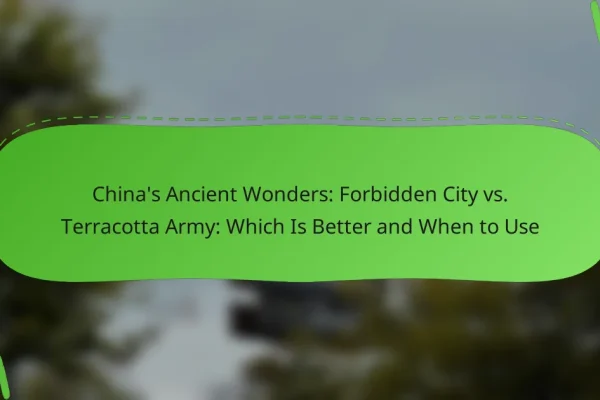What are the top historical sites to visit in China?
China is home to numerous historical sites that reflect its rich cultural heritage. The most notable sites include the Great Wall, the Forbidden City, the Terracotta Army, the Summer Palace, and the Potala Palace, each offering unique insights into China’s history and architecture.
The Great Wall of China
The Great Wall of China is one of the most iconic structures in the world, stretching over 13,000 miles. Built primarily during the Ming Dynasty, it served as a defense mechanism against invasions and is a UNESCO World Heritage site.
Visitors can explore various sections, such as Badaling and Mutianyu, which are well-preserved and accessible. Hiking along the wall offers stunning views of the surrounding landscapes, making it a memorable experience.
The Forbidden City
The Forbidden City, located in Beijing, was the imperial palace for 24 emperors during the Ming and Qing dynasties. This sprawling complex consists of nearly 1,000 buildings and is the largest ancient palatial structure in the world.
When visiting, consider taking a guided tour to fully appreciate the intricate architecture and historical significance. The entrance fee is typically around 60 CNY, and it’s advisable to book tickets in advance, especially during peak tourist seasons.
The Terracotta Army
The Terracotta Army, discovered in Xi’an, consists of thousands of life-sized clay soldiers buried with China’s first emperor, Qin Shi Huang. This archaeological wonder dates back to the 3rd century BC and is a UNESCO World Heritage site.
Visitors can explore the three main pits where the soldiers are located, with Pit 1 being the most impressive. Guided tours are available, and it’s recommended to allocate at least half a day to fully experience the site.
The Summer Palace
The Summer Palace in Beijing is a vast ensemble of lakes, gardens, and palaces, serving as a royal retreat during the Qing Dynasty. It is renowned for its beautiful landscapes and classical Chinese architecture.
When visiting, take a boat ride on Kunming Lake or stroll through the Long Corridor to enjoy the scenic views. Entrance fees are around 30 CNY, and the site is best visited in spring or autumn for pleasant weather.
The Potala Palace
The Potala Palace in Lhasa, Tibet, is a stunning architectural marvel that served as the winter residence of the Dalai Lama. This UNESCO World Heritage site is famous for its towering structure and intricate murals.
Visitors should be prepared for high altitudes and consider acclimatization before touring. Entrance tickets can be purchased on-site, but it’s advisable to check for any restrictions or requirements due to local regulations.
What are the historical significance and cultural heritage of these sites?
The historical significance and cultural heritage of China’s historical sites reflect the nation’s rich past and diverse traditions. These sites, such as the Great Wall, Forbidden City, and Terracotta Army, offer insights into ancient Chinese civilization, showcasing architectural achievements, cultural practices, and historical events that have shaped the country.
Great Wall’s role in defense
The Great Wall of China was primarily built as a defense mechanism against invasions and raids from nomadic tribes. Stretching over 13,000 miles, it served as a formidable barrier, with watchtowers and fortresses strategically placed for surveillance and communication.
Throughout its history, the Wall underwent various constructions and renovations, particularly during the Ming Dynasty, when it was reinforced with bricks and stone. This period marked a significant enhancement in its defensive capabilities, making it a symbol of national strength and unity.
Forbidden City’s imperial history
The Forbidden City served as the imperial palace for 24 emperors during the Ming and Qing Dynasties, symbolizing the political and cultural heart of China. Its vast complex, comprising nearly 1,000 buildings, reflects traditional Chinese palatial architecture and the principles of feng shui.
As a UNESCO World Heritage Site, the Forbidden City not only represents the power of the emperors but also houses invaluable artifacts and artworks that narrate the story of China’s imperial history. Visitors can explore its intricate halls and courtyards, gaining insight into the lives of emperors and their courts.
Terracotta Army’s burial practices
The Terracotta Army, discovered in 1974, was created to accompany the first Emperor of China, Qin Shi Huang, in the afterlife. This vast collection of life-sized statues, numbering in the thousands, reflects the emperor’s belief in the afterlife and the importance of burial practices in ancient China.
Each figure is unique, showcasing detailed craftsmanship and varying ranks, from generals to foot soldiers. The army was intended to protect the emperor in death, illustrating the elaborate burial customs and the significance of the afterlife in Chinese culture.
How to plan a visit to historical sites in China?
Planning a visit to historical sites in China involves researching locations, understanding cultural significance, and considering travel logistics. Focus on major sites like the Great Wall and the Forbidden City, and plan your itinerary around peak visiting times and local customs.
Best time to visit
The best time to visit historical sites in China is during spring (April to June) and autumn (September to November) when the weather is mild and crowds are manageable. Summer can be hot and humid, while winter may bring cold temperatures, especially in northern regions.
Consider local festivals, such as the Chinese New Year, which can enhance your experience but also lead to larger crowds and higher prices. Booking accommodations and tickets in advance during peak seasons is advisable.
Travel tips and guidelines
When visiting historical sites, dress appropriately and be respectful of local customs and traditions. Many sites have specific rules regarding photography and behavior, so familiarize yourself with these before your visit.
Be prepared for varying levels of accessibility at different sites. Some may require extensive walking or climbing, so wear comfortable shoes and stay hydrated. Always check for any entry fees or required permits ahead of time.
Local transportation options
China offers various transportation options for reaching historical sites, including high-speed trains, buses, and taxis. High-speed trains are particularly efficient for traveling between major cities and can significantly reduce travel time.
Within cities, public transportation like subways and buses is affordable and convenient. Rideshare apps are also popular for short distances. Consider purchasing a transportation card for ease of use and savings on fares.
What are the entry fees and ticketing options for these sites?
Entry fees for historical sites in China vary widely based on the location and type of site. Most major attractions offer a range of ticketing options, including standard admission, guided tours, and discounts for certain groups.
Great Wall ticket prices
The ticket prices for the Great Wall can range from around 40 to 100 CNY, depending on the section you visit. Popular areas like Badaling tend to be more expensive, while less commercial sections, such as Jiankou, may have lower fees.
Some sections of the wall may charge additional fees for cable cars or special access areas. It’s advisable to check the specific section’s website for the most accurate pricing and any seasonal variations.
Forbidden City entry fees
Entry to the Forbidden City typically costs around 60 CNY during peak seasons and may be lower during off-peak times. Tickets can be purchased on-site, but it’s recommended to buy them online in advance to avoid long queues.
Visitors should note that the Forbidden City has specific visiting hours and may limit the number of tickets sold each day. Planning your visit ahead of time can enhance your experience.
Discounts for students and seniors
Many historical sites in China, including the Great Wall and the Forbidden City, offer discounts for students and seniors. Students may receive a reduced ticket price upon presenting a valid student ID, while seniors often enjoy discounted rates or free entry.
It’s important to check the specific site’s policies regarding discounts, as they can vary. Always carry valid identification to ensure you can take advantage of these offers.
What are the local variants of historical sites in different regions of China?
China’s historical sites vary significantly across its diverse regions, reflecting the unique cultural, architectural, and historical influences of each area. From ancient temples in the south to imperial palaces in the north, these sites offer a glimpse into the country’s rich heritage.
Eastern China: Temples and Gardens
Eastern China is renowned for its classical gardens and ancient temples, particularly in cities like Suzhou and Hangzhou. The gardens, such as the Humble Administrator’s Garden, showcase intricate landscaping and traditional Chinese aesthetics, while temples like Lingyin Temple offer spiritual insights and architectural beauty.
Visitors should consider the seasonal variations when planning their trips, as spring and autumn provide the most pleasant weather for exploring these outdoor sites. Entry fees typically range from low to moderate, making them accessible for most travelers.
Western China: Ancient Silk Road Sites
Western China features historical sites linked to the ancient Silk Road, such as the city of Dunhuang and the Mogao Caves. These sites are famous for their stunning frescoes and Buddhist art, reflecting the cultural exchanges that took place along this historic trade route.
Travelers should be aware that some sites may require permits for entry, especially those in remote areas. Guided tours are often recommended to fully appreciate the historical context and significance of these locations.
Southern China: Minority Cultures and Architecture
Southern China is home to various ethnic minority groups, each with unique historical sites that highlight their distinct cultures. Places like the Dong villages in Guizhou feature traditional wooden architecture and vibrant festivals that attract visitors interested in cultural immersion.
When visiting these areas, it’s advisable to respect local customs and traditions. Engaging with local guides can enhance the experience, providing deeper insights into the heritage and practices of these communities.
Northern China: Imperial Palaces and Great Walls
Northern China is famous for its imperial palaces, such as the Forbidden City in Beijing, and the Great Wall, which stretches across several provinces. These monumental sites are essential for understanding China’s dynastic history and architectural achievements.
Visitors should plan ahead, as these popular sites can be crowded, particularly during peak tourist seasons. Booking tickets in advance and visiting during off-peak hours can improve the experience significantly.











